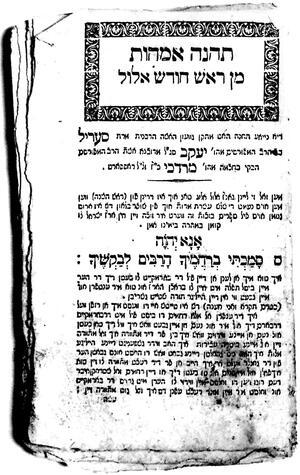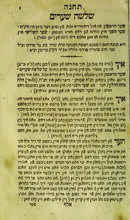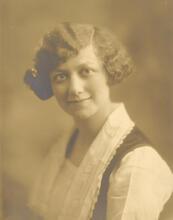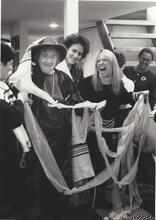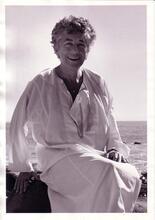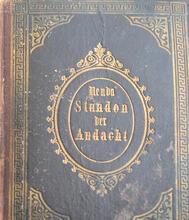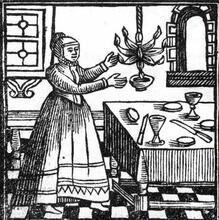Tkhines
This tkhine, the Thkine of the Matriarchs for the New Moon of Elul, was one of dozens of collections of prayers published in Yiddish intended for women, who usually were not educated in Hebrew or Aramaic. Thkine of the Matriarchs for the New Moon of Elul by Serl bat R' Yankev Sega"l of Dubno, 1874. Source: Wikimedia Commons
Barred from an education in Hebrew or Aramaic for centuries, many Jewish women in Europe were unable to read sacred Jewish texts. Beginning in the sixteenth century, however, men and women began publishing tkhines, collections of prayers in Yiddish intended to be more accessible for a female audience. Prayers addressed many themes of domestic and family life, though some suggested women ought to be allowed in traditionally male spaces as well. Moreover, tkhines provide evidence of women’s religious lives in Europe from the sixteenth to the nineteenth century.
Because most Jewish texts of the sixteenth through the eighteenth centuries, as throughout most of Jewish history, were written in Hebrew by men for other men, we have very little direct evidence of women’s religious lives. Tkhines (Yiddish, from Hebrew tehinnot, “supplications”), private devotions and paraliturgical prayers in Yiddish, primarily for women, were published beginning in the early modern period, especially in Central and Eastern Europe and among Yiddish-speaking populations elsewhere. Written by both women and men, they were printed and reprinted again and again, thus providing evidence of their great popularity. Moreover, we can document some of the seventeenth- and eighteenth-century women who composed them. Thus, these prayers are among the most important resources for the history of the religious lives of Jewish women in the Yiddish-speaking world.
Literary Setting
As is well-known, the great classics of Jewish literature were almost always written in Hebrew and Aramaic, known collectively as “the holy tongue,” by a small group of learned men, for others in the same intellectual elite. Very few women learned more than the rudiments of Hebrew, and those Central and Eastern European Jewish women who could read were usually literate only in the vernacular Yiddish. However, during the sixteenth and seventeenth centuries, new rituals and new genres of religious literature, directed at new audiences, arose among Jews. This was a result partially of certain developments within The esoteric and mystical teachings of JudaismKabbalah during this period, as well as general European religious trends, and was facilitated by the rise of printing. For the first time, book production was cheap enough for broad masses of people to have access to published materials. Thus, new genres of literature emerged for a non-scholarly audience, which included women.
Guides to the ethical life, books of pious practices, new liturgies and rituals, often in abridged and simplified form, were published both in Hebrew, for an audience of men with a basic education in classical Jewish texts, and in Yiddish, for women and for men “who are like women,” i.e. those without much knowledge of Hebrew. Many of these new publications (including Hebrew tehinnot, supplemental prayers for men) developed out of and popularized a mystical pietism originating among the kabbalists of Safed; others originated among secret followers of Sabbetai Zevi (1626–1676), the failed mystical messiah. Tkhines were an important form of women’s participation in this pietistic revival and its popular literature. Indeed, this religious movement was accessible to women precisely because it was spread largely by literary means. Interestingly, however, tkhines from the end of the eighteenth century show little evidence of influence from hasidism. Hasidic teachings, especially in the early years of the movement, were transmitted orally from master to disciple in small groups that excluded women.
In printed tkhine collections, each individual prayer begins with a heading directing when and sometimes how it should be recited: “A pretty tkhine to say on the Sabbath with great devotion;” “A tkhine that the woman should pray for herself and her husband and children;” “A confession to say with devotion, not too quickly; it is good for the soul;” “When she comes out of the ritual bath;” “What one says on the Eve of The Day of Atonement, which falls on the 10th day of the Hebrew month of Tishrei and is devoted to prayer and fasting.Yom Kippur in the cemetery;” “When the Ram's horn blown during the month before and the two days of Rosh Ha-Shanah, and at the conclusion of Yom Kippur. shofar is blown on The Jewish New Year, held on the first and second days of the Hebrew month of Tishrei. Referred to alternatively as the "Day of Judgement" and the "Day of Blowing" (of the shofar).Rosh Ha-Shanah, say this.” Scholars are divided as to whether these prayers were meant as a women’s substitute for the Hebrew liturgy, or as supplementary, voluntary prayers, recited when women wished. Although some tkhines were intended to be recited in the synagogue, and a few were specifically for male worshipers (“A lovely prayer for good livelihood to be said every day by a businessman”) the majority were associated with women’s spiritual lives in the home or other, unspecified locations: prayers to be recited privately for each day of the week, on Sabbaths, festivals, fasts and New Moons, for the three “women’s commandments,” for pregnancy and childbirth, for visiting the cemetery, for private griefs such as childlessness and widowhood, for recovery from illness, for sustenance and livelihood, for confession of sins. While domestic concerns run through these prayers, so, too, do grander themes from Jewish thought, especially the hope for the messianic redemption and the end of exile.
Although there are manuscript tkhines, none are known that precede the appearance of the genre in print. There are two main groups of tkhines: first, those that were printed in Western and Central Europe in the seventeenth and eighteenth centuries, which, although published anonymously, were probably written or compiled by men for women; and second, those that appeared in Eastern Europe in the seventeenth, eighteenth and early nineteenth centuries, often with named authors or compilers, some of whom were women. The geographical designation refers primarily to place of printing, rather than place of composition, which is more difficult to determine, and is intended to suggest, as well, a rough periodization, with certain overlaps. The language of the tkhines (known from the seventeenth century on as “tkhine-loshn”) is relatively fixed, rather like an increasingly archaic “prayer-book English,” and displays few of the distinctive linguistic features of the developing Eastern European varieties of Yiddish; thus, linguistic analysis is of little help in determining place of composition.
Regional Tkhines
Western European tkhines were published in collections of between 35 and 120 prayers, addressing many topics: either in small books or as appendices to Hebrew prayerbooks, often prayer books with Yiddish translation. The first major collection, entitled simply Tkhines, was published anonymously in Amsterdam in 1648. The introduction to the work sets out the author or editor’s motivations in publishing the book:
Now our sages have composed many praises … and prayers to the Almighty God … in the holy tongue, which women usually do not understand. … It is like a blind person standing at a window and looking out at the street to see wondrous things—this is the same as women saying the tehinnot in the holy tongue and not knowing what they are saying … Thus I could not excuse myself from acceding to [women’s] desire … so that she will be able to understand the prayers … For prayer comes from the heart, and when the heart does not know what the mouth speaks, the prayer helps but little.
Numerous reprints (usually entitled Seyder tkhines), expansions and additional collections followed. In the mid-eighteenth century, Seyder tkhines u-vakoshes (“Order of supplications and petitions,” Fürth: 1762, although there may be one or two earlier editions), a comprehensive collection incorporating several earlier works, emerged and was repeatedly reprinted, with alterations, over the next 150 years, first in Western, and then in Eastern Europe. These various Western European texts convey the holiness to be found in the domestic and the mundane, in the activities of a wife and mother, but they also depict the angels, the patriarchs and matriarchs, the male and female heroes of Jewish history, and the ancient Temple that stood in Jerusalem.
The very earliest Eastern European tkhines were published in Prague. Eyn gor sheyne tkhine (“A very beautiful Tkhine,” ca. 1600) is one of the first to claim female authorship: it is attributed to “a group of pious women.” Two other Prague imprints, one from the turn of the eighteenth century and the other from 1705, are attributed to women: Rachel daughter of Mordecai Sofer of Pinczow and Beila daughter of Ber Horowitz. Like many other Eastern European texts, all three of these Prague tkhines were short and dealt with only a single subject each, such as a tkhine “to be recited with devotion every day.” However, one notable work, Seyder tkhines (Prague: 1718), was written by a man, Mattithias ben Meir Sobotki, formerly rabbi of Sobota, Slovakia, explicitly for a female audience. “My dear women,” he writes, “… I have made this tkhine for you in Yiddish, in order to honor God and … to honor all the pious women. For there are many women who would gladly awaken their hearts by saying many tkhines.” This work contains 35 prayers on a variety of topics, with many prayers for the Days of Awe and for pregnancy, childbirth, and infertility. Surprisingly, this male author introduces a personal subjectivity in a female voice into many of these tkhines. They are written as the prayers of women struggling with misfortune (infertility, widowhood) or danger (a husband on a hazardous journey). One of the tkhines for infertility begins: “Lord of the whole world, I, poor woman, come before you to bemoan my suffering and the sorrow I carry in my heart.” Note that this is Mattithias Sobotki speaking, imaginatively taking on a woman’s persona. Interestingly, the author’s name disappears from later editions of this work, which becomes known simply as “The Prague Tkhine [Preger tkhine].”
Except for the Prague imprints, the Eastern European tkhines were typically printed as small pamphlets, usually under twenty pages long, on bad paper with crabbed type, often with no imprint, making their bibliographic history difficult to trace. Books of tkhines originating in eighteenth-century Eastern Europe, especially in Galicia, Volhynia, and Podolia (now parts of Poland, Belarus, and the Ukraine), tended to deal with a smaller number of subjects (such as the High Holidays and the penitential season) and were often attributed to a single author. Because a significant number of these authors were women, these texts allow us, for the first time, to hear women’s voices directly. Important examples include: Tkhine imohes fun rosh khoydesh elul (“Tkhine of the Matriarchs for the New Moon of Elul” [and the entire penitential season]; Lviv, n.d.), by Serl daughter of Jacob ben Wolf Kranz (the famed Preacher of Dubno, 1741–1804), which calls on the four biblical matriarchs (Sarah, Rebecca, Rachel, and Leah) to come to the aid of the worshipper and plead her case before the heavenly court; two short tkhines by Leah Dreyzl (mid-eighteenth century), daughter of Moses of Zolkiew and Nehamah Naytshe, which, in the form of powerful sermons, call on women to repent their sins; Tkhine imohes (“Tkhine of the [biblical] Matriarchs”) for the Sabbath before the New Moon, by Leah Horowitz (eighteenth century), which argues for the power of women’s prayer and quotes from rabbinic and kabbalistic sources; and Shloyshe sheorim (“The Three Gates”), attributed to Sarah bas Tovim (eighteenth century), which contains three sections: one for the three “women’s commandments,” one for the High Holidays and one for the Sabbath before the New Moon. These Eastern European authors have distinctive literary styles and concerns. In contrast to Western European texts, the tkhines of Leah Horowitz and Sarah bas Tovim suggest that women should take part—in some fashion—in such traditionally male activities as synagogue prayer and Torah she-bi-khetav: Lit. "the written Torah." The Bible; the Pentateuch; Tanakh (the Pentateuch, Prophets and Hagiographia)Torah study. Both of these authors also write of hopes, prayers, and rituals to bring about the coming of the Messiah. Serl and Leah Dreyzl, by contrast, focus on the inner life and repentance of the individual woman.
Changes in the Nineteenth Century
By the mid-nineteenth century, the genre had undergone significant change. Jews in Central and Western Europe had largely abandoned Yiddish; books comparable to tkhines were published first in Germanized Yiddish, then in German in Yiddish characters and finally in German. However, these texts breathed an entirely new sensibility, influenced by the rising ideal of the bourgeois family, with its stress on sentiment and emotional family ties and its new definition of gender roles. The authors of these collections of prayers for women in German, published throughout the nineteenth century and into the twentieth, were almost all men. However, the most popular work of this type was Stunden der Andacht (“Hours of Devotion”) by Fanny Neuda (1819-1894). First published in 1855, this work went through at least 28 editions up until the 1920s. Martha Wertheimer published a special, revised version in 1936, addressing the conditions of Nazi Germany.
In Eastern Europe as well, the ideal of the bourgeois family came into play in nineteenth century tkhines, but in a rather different fashion. female/sing.: Member of the Haskalah movement.Maskilim, or “enlighteners,” men who wished to reform Eastern European Jewish life, wrote tkhines to reach the “benighted” traditional women with their reform program. Unlike earlier tkhine authors, female or male, they scorned their audience and the genre and wrote the prayers in a highly emotional style they thought would appeal to their audience. Often, because they thought they could thus sell more books, they attributed their works to female authors, either those who had actually written tkhines a century earlier or creations of their own imagination. (Because the maskilic practice of using female pseudonyms was well known, earlier scholars were skeptical of any attributions to female authorship. However, as we have seen, many seventeenth and eighteenth century women authors can be authenticated.) Alongside these newer maskilic tkhines, older texts and collections, both those originally published in Western Europe and those originally published in Eastern Europe, continued to be reprinted in Eastern Europe in numerous editions up until the Holocaust, often revised or garbled by the printers. In the early decades of the twentieth century, tkhines in Yiddish were also published in North America and other areas to which Eastern European Jews migrated.
The tkhines reveal a whole world of women’s religious lives, concerns, customs and settings for prayer. These texts are deeply spiritual, no less than the complex and esoteric works produced by Kabbalists and hasidic masters. The women (and men) who composed these prayers for women addressed the spiritual issues of their day, whether on the level of domestic piety or national redemption. The tkhines themselves are at home in the literature produced for the intellectual “middle class” of this period; they belong among the guides to the upright life, books of customs, condensations of guides to pious practices, and digests of mystical teachings that were read by householders and artisans. Indeed, the tkhines show how much women were a part of this intellectual and spiritual world. Finally, the tkhines provide a directness of passionately emotional personal prayer, mostly absent from the more collective and formalized male worship experience.
Recent Developments
As the use of Yiddish declined among emigrants from Eastern Europe in the late nineteenth and the twentieth centuries, and the Yiddish-speaking heartland was destroyed by the Holocaust, the genre of tkhines nearly disappeared, except among hasidim and other isolated traditional Yiddish-speaking populations. Since the 1980s, however, the tkhines have aroused new interest in both scholars and members of the Jewish public. Jewish women, in particular, have sought to find a “usable past” in which to root themselves. Jewish feminists have found role models in the historical tkhines uncovered by scholars and have also written new tkhines in their current vernaculars, English or Hebrew. Some new tkhines (and translations of old tkhines) are included in recent Conservative and Reconstructionist prayer books, while others have been published in anthologies of contemporary women’s prayers and writings. Some Orthodox women have turned to the traditional tkhines in Yiddish as a direct expression of Jewish women’s spirituality. This is despite the fact that many young Orthodox women today do not know Yiddish and are well educated in the Hebrew prayer book and classical sources in Hebrew; the Yiddish tkhines are published with English translation.
Kay, Devra. Seyder Tkhines: The Forgotten Book of Common Prayer for Jewish Women. Philadelphia: 2004.
Kratz-Ritter, Bettina. Für “fromme Zionstöchter” und “gebildete Frauenzimmer.” Hildesheim: 1995.
Niger, Shmuel. “Di yidishe literatur un di lezerin.” In Bleter geshikhte fun der yiddisher literatur. New York: 1959 (first published 1912).
Shulman, Eleazar. Sefat yehudit-ashkenazit ve-sifrutah. Riga: 1913.
Weissler, Chava. Voices of the Matriarchs: Listening to the Prayers of Early Modern Jewish Women. Boston: 1998.
Zinberg, Israel. A History of Jewish Literature. vol. 7. Cincinnati: 1975.

